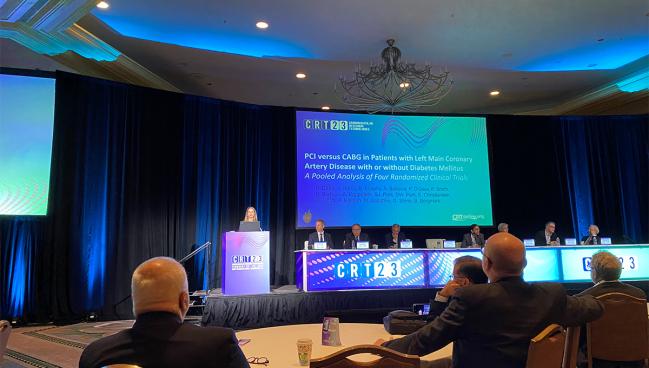In CABG/PCI Decisions for Left Main Disease, Diabetes ‘Still Matters’
While both treatments had similar 5-year all-cause mortality in a meta-analysis, other endpoints made the case for nuance.

WASHINGTON, DC—Among patients undergoing revascularization for left main disease who were deemed equally suitable for PCI or CABG, those with diabetes have higher rates of all-cause death, cardiovascular death, spontaneous MI, and repeat revascularization at 5 years, according to a meta-analysis of four randomized, controlled trials.
“Taken together, our findings suggest that both PCI and CABG are reasonable revascularization strategies in patients with left main disease and diabetes with some trade-offs related to nonfatal cardiovascular events,” said Prakriti Gaba, MD (Harvard Medical School, Boston, MA), who presented the results during a late-breaking trial session at CRT 2023.
Pointing out that the data in this study aren’t new per se, Society of Thoracic Surgeons President Thomas MacGillivray, MD (MedStar Washington Hospital Center, Washington, DC), commented to TCTMD that the “big benefit of analyses like these is it keeps us thinking about it, and I think that for individual patients, that really helps because in the cath lab or in the ward you realize that these are a complex group of patients [for whom] I think we should individualize their care based on what their comorbidities are and what their coronary anatomy is.”
What often happens following the presentation or publication of a major trial like , MacGillivray continued, is “people think the question is answered. I think that, if nothing else, many of these trials don't provide an answer—they raise more questions. Although that can be somewhat frustrating, it does help advance the care of our patients.”
Diabetes and All-Cause Mortality
For the study, Gaba and colleagues pooled data from four trials comparing PCI and CABG in patients with left main disease who were judged to be eligible for either procedure: SYNTAX (n = 705), PRECOMBAT (n = 600), NOBLE (n = 1,184), and EXCEL (n = 1,905). Of the 4,390 patients included (mean age 65 years; 75% male), about one-quarter had diabetes, and these patients generally carried a higher comorbidity burden.
At 5 years, all-cause mortality, the primary endpoint, was significantly higher for those with diabetes than those without (14.7% vs 9.3%; adjusted HR 1.62; 95% CI 1.32-2.00) as were the secondary endpoints of cardiovascular death (9.0% vs 5.1%; adjusted HR 1.78; 95% CI 1.35-2.34), spontaneous MI (6.7% vs 3.7%; adjusted HR 1.65; 95% CI 1.18-2.31), and repeat revascularization (18.5% vs 13.2%; adjusted HR 1.41; 95% CI 1.17-1.70).
If nothing else, many of these trials don't provide an answer—they raise more questions. Thomas MacGillivray
When comparing outcomes after PCI and CABG, 5-year all-cause mortality was similar for both procedures in diabetics (15.3% vs 14.1%; HR 1.11; 95% CI 0.82-1.52) and nondiabetics (9.7% vs 8.9%; HR 1.08; 95% CI 0.86-1.36; P for interaction = 0.87). A similar pattern was observed for cardiovascular death, and while spontaneous MI was higher for those receiving PCI over CABG, there was no difference in incidence between diabetics and nondiabetics. Repeat revascularization risk was also higher for PCI compared with CABG and was more pronounced for diabetics (HR 2.12; 95% CI 1.56-2.87) over nondiabetics (HR 1.65; 95% CI 1.35-2.02; P for interaction = 0.03).
For periprocedural MI, there was a benefit for CABG at 5 years over PCI when using the protocol definition but not the UDMI definition used in both the SYNTAX and EXCEL trials. However, there were no differences here between diabetics and nondiabetics.
Lastly, the risk of stroke within the first year after randomization was lower with PCI compared with CABG regardless of diabetes status (P for interaction = 0.51), but this relationship attenuated through 5 years, still with no interaction with diabetes status (P for interaction = 0.29).
Gaba said that, because all patients included in this analysis were considered by a multidisciplinary heart team to be equally suitable for PCI or CABG, “these findings may not be applicable to all patients we see in practice.”
Also, “these trials predated the widespread use of novel classes of diabetes therapies such as GLP-1 receptor agonists or SGLT2 inhibitors,” she acknowledged. “Thus, we may not be able to comment on all cardiovascular outcomes in these cases.”
Taken together with the fact that both PCI and CABG techniques have evolved over time, “these findings are ultimately hypothesis generating,” Gaba concluded.
‘Diabetes Still Matters’
Although left main trials—most notably EXCEL and NOBLE—have been extensively discussed since their publication, session co-moderator Robert A. Byrne, MBBCh, PhD (Mater Private Hospital, Dublin, Ireland), congratulated the investigators for doing “a great service to the community by combining the data and presenting it for us in this data set” even though they ultimately found no evidence of interaction between diabetes status and revascularization strategy for the primary endpoint.
Panelist Spencer King III, MD (Emory University, Atlanta, GA), commented that the data look very similar to those shown in the EAST trial, which was published in the New England Journal of Medicine way back in 1994. Today, “what I’m getting from practitioners is this idea that diabetes doesn’t matter,” he said. “What I get from your data is that diabetes still matters. The patients in the trials are the patients in the trials, but the patients that we’re seeing every day have other reasons to go for surgery or PCI. I think this is very helpful for people to see but I think the idea that diabetes doesn’t matter is not a correct idea.”
I think the idea that diabetes doesn’t matter is not a correct idea. Spencer King
Something to keep in perspective, however, is that most real-life patients aren’t eligible for both PCI and CABG like those in this study, stressed panelist Kendra Grubb, MD (Emory University). “The patients being sent to me with diabetes have disease that the person who did the angiogram thought should go to surgery,” she said. “We have to be careful about who we’re actually capturing in this data and how it actually applies to the broader population.”
MacGillivray agreed. “It’s not the most common scenario that we see isolated left main disease,” he said. “Left main disease is most commonly associated with three-vessel coronary artery disease. One of the criticisms was that the majority of patients with left main disease this does not apply to because they have also multivessel coronary artery disease. Certainly, there has been a lot of discussion about some of the definitions and data points over the years, but . . . diabetes does matter.
Going forward, panelist George Dangas, MD, PhD (Icahn School of Medicine at Mount Sinai, New York), stressed, it’s important to keep in mind secondary prevention. “That may be the key because in general the events are quite high in both groups,” he said. “We’re bickering about the differences, but meanwhile the absolute event rates are sizeable in both groups and we can do better in all patients by aggressive lipid-lowering, perhaps PCSK9 inhibitors and glycoprotein A strategies, extended clopidogrel use and all that, and none of those things were used in this trial, so we look forward to future advances in the field.”
As for whether this study represents a win or loss for PCI, MacGillivray said “the fact that the incidence of spontaneous MI is significantly higher in the PCI group is hard to ignore.”
Yael L. Maxwell is Senior Medical Journalist for TCTMD and Section Editor of TCTMD's Fellows Forum. She served as the inaugural…
Read Full BioSources
Gaba P. PCI versus CABG in patients with left main coronary artery disease with or without diabetes mellitus: a pooled analysis of four randomized clinical trials. Presented at: CRT 2023. February 26, 2023. Washington, DC.
Disclosures
- Gaba reports no relevant conflicts of interest.





Comments